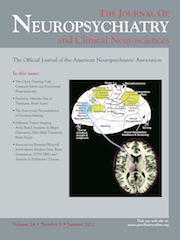Psychiatric Comorbidity in Arousal Disorders: Chicken or Egg?
To the Editor: Arousal disorder (AD) is the term used to describe undesirable behaviors occurring as a result of abnormal transition between wakefulness and nonrapid eye movement (NREM) sleep. AD includes sleepwalking, sleep talking, confusional arousals, and sleep terrors. Psychological factors have been associated with certain Ads,1,2 and comorbid mood disorders have been described with sleep terrors and sleepwalking.2 Our aim was to pragmatically determine the prevalence of anxiety and depression in a population of AD patients attending a tertiary-referral sleep clinic by using a questionnaire audit. Specific consent was considered unnecessary by the local research ethics committee.
All patients with AD without another sleep disorder and diagnosed by International Classification of Sleep Disorder Version 2 criteria (ICSD-2) were sent a previously validated Short Form-12 (SF-12) questionnaire, and the Hospital Anxiety and Depression Scale (HADS). Results were compared with mean values specific to the United Kingdom. Statistical analysis was performed with SPSS (Version 14, Chicago, IL).
Questionnaires were sent to 86 AD patients; 45% (N=39) were completed and returned. The mean age was 40 years (range: 18 to 67; SD: 11); 56% of respondents were female. Only 7 respondents (18%) had nightly symptoms; however, 87% (N=34) considered their problem moderately/very severe. The prevalence of self-reported psychiatric disorders was 26% (N=10). The SF-12 physical component summary scores were not statistically different between AD patients (51.6; SD: 8.1) and U.K. normative data (50.9; SD: 9.4); the SF-12 mental component summary scores were significantly lower in respondents (46.9; SD: 10.7) than in U.K. normative data (52.1; SD: 8.7; p<0.00001).3 HADS scores were higher in AD (7.8; SD: 4.9) for anxiety as compared with general population (6.14; SD: 3.76; p=0.03), as was depression (4.3; SD: 4.3), as compared with U.K. populations (3.68; SD: 3.07; p=0.04).4
Our study is the first to evaluate ADs using HADS and SF-12 together and to demonstrate that these questionnaires together can detect symptoms of poor mental health in patients with ADs. These techniques support the findings of earlier studies that patients with ADs have a higher than expected prevalence of psychiatric symptoms.
However, the reasons for the increased prevalence of psychiatric symptoms are unclear from this brief audit. In sleepwalking, psychiatric treatment does not improve the parasomnia;5 conversely, studies have failed to show an increased incidence of ADs in patients with anxiety disorders.1 Thus, we argue that mood disturbances in ADs are neither “chicken” nor “egg.” The increased co-occurrence of psychiatric comorbidity and its role in ADs and vice-versa requires more detailed exploration than has hitherto been undertaken. We call for large, prospective, controlled trials in patients with AD that include structured and detailed personality assessments and that also evaluate treatment measures and their impact.
1 : Factors that predispose, prime, and precipitate NREM parasomnias in adults: clinical and forensic implications. Sleep Med Rev 2007; 11:5–30, discussion 31–33Crossref, Medline, Google Scholar
2 : Sleepwalking and night terrors: psychopathological and psychophysiological correlates. Int Rev Psychiatry 2005; 17:263–270Crossref, Medline, Google Scholar
3 : Cross-validation of item selection and scoring for the SF-12 Health Survey in nine countries: results from the IQOLA Project. International Quality of Life Assessment. J Clin Epidemiol 1998; 51:1171–1178Crossref, Medline, Google Scholar
4 : Normative data for the HADS from a large non-clinical sample. Br J Clin Psychol 2001; 40:429–434Crossref, Medline, Google Scholar
5 : Adult chronic sleepwalking and its treatment based on polysomnography. Brain 2005; 128:1062–1069Crossref, Medline, Google Scholar



